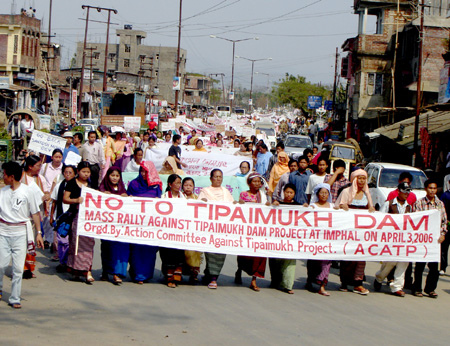Hijam Heramot Singh
“ Flow gently, sweet Barak, among thy green braes, We’ll be damming thee up in a couple o’days,”
(To reflect the persistence of the proponents of the Tipaimukh Dam Project the writer has adapted a poem by Robert Burns – the Scottish poet of lovely lasses and unspoiled beauty. )
It is a fact that the planning of the Tipaimukh Dam Project was done by the Govt. of India without proper research on its social and environmental impact in Manipur. The Govt. of Manipur should, therefore, negotiate with the centre for adequate compensation to the state and indigenous people inhabiting the Project area after re-assessing the exact damage the project would cause to the land, wildlife and the culture of thousands of families around the project. The state Govt. should take a cue from the James Bay and Northern Quebec agreement, signed in 1975 by the Canadian Govt., the province of Quebec, the Cree Indians, and Inuit ( whose communities were affected by the James Bay project which flooded more than six thousand square miles threatening the livelihood of thousands of Cree Indians and the Inuits.) In effect the agreement permitted completion of the 1st phase of the James Bay project ( La Grande Power Plants ), compensated the Cree and Inuit with money packages totalling 225 million dollars, and promised them the rights to govern, hunt, fish, and trap on their traditional lands. The agreement follows the decision of the Quebec Court of Appeal overturning the 1973 Court injunction to stop construction of La Grande projects.

On completion of the Tipaimukh Dam Project, a lake of 240 sq. Km. will be created in the project area and consequently thousands of people around the lake will lose their livelihood. Therefore these people are to be given alternative means of earning income. For this several new projects are to be taken up around the project. Some of the people may be given employment in the Dam Project itself. It will not be good for the people of Manipur to oppose the construction of the Darn because it will harm the friendly relation between Manipur and its neighbouring states i.e. Assam and Mizoram. These states want the co-operation of Manipur to expedite the construction of the project. Manipur should sacrifice something to help her neighbours. This may bring about a change in the interstate relations in the Northeast and consequently Assam may come forward to work for amity between Manipur and Nagaland. It is true that the Tipaimukh project will damage the environment completely in about 300 sq. km. But it is also true that the project will improve the environment substantially in about 5000 sq. km. in and around Tamenglong and Churachandpur where there is an increasing environmental degradation due to burning down of trees and shrubs by Nagas, Kukis and Mizos for jhum cultivation because the project will create infrastructures to start new projects to give alternative occupation to the thousands of tribals who are now practising jhum cultivation.
The Americans had their Age of Dams. It was in 1941, and Guthrie had been hired for $266.66 to spend a month writing songs for the fledging Bonneville Power Administration in praise of the development of water.” Ballad of the Great Grand Coulee”,” New Found Land “,” Pastures of Plenty “.It was a time of almost mystical enthusiasm. The young engineers of the US Bureau of Reclamation, the Army Corps of Engineers, and the Tennessee Valley Authority were going to wrestle the energy from rivers, cultivate the deserts,and put America to work. And after years of dustblown expectations, young Americans could suddenly be part of the mightiest thing. Concrete! Work! Adventure! Power!
“ I just want to have worked on that dam,” a young philosophy student told a friend at the University of Washington in 1935, before quitting school to get a job building Grand Coulee. The friend remembered it later as a credo of the time : “ If our generation has anything good to offer history,” the philosopher said,” it’s that dam. Why, the thing is going to be completely useful. It is going to be a working pyramid.”
This was an understatement. What human beings did in less than half a century was so extraordinary you can only compare it to a force of geology, except that it happened almost overnight. The Tennessee Valley Authority was created in 1933, and Hoover Dam was completed in 1935 – the same year that that student decided to leave Plato and go pour concrete in the cause of perfect usefulness. From then on the juggernaut was almost unstoppable for 40 years. The Allies’ air superiority is in World War II was built in part by new aluminium plants which were fired by Columbia River dams. A Depression-era project to tame the wild Tennessee River and its tributaries became perhaps the best-known public works of Franklin Roosevelt’s presidency. The Tennessee Valley Authority’s 47 dams, most built after a bruising battle over what Roosevelt’s foes called his “ Socialism”, generate power for a once underdeveloped region. There are now about 75,000 dams in the United States. And Manipur will be entering its Age of Dams with the construction of the dam across the Barak river at Tipaimukh. It is heartening to note that the State Govt. is planning to construct a number of dams in the near future for water management and power development. These dams will bring prosperity and happiness to the people of Manipur.
Reference :
The National Geographic Special Edition on Water
The Power,Promise, and Turmoil of
North America’s Fresh Water.
Published by the National Geographic Society,
Washington DC, U.S.A




